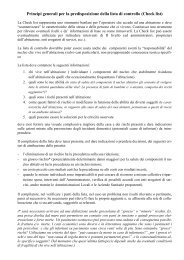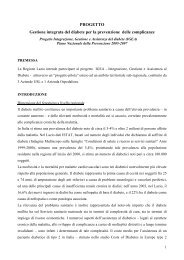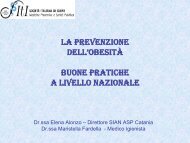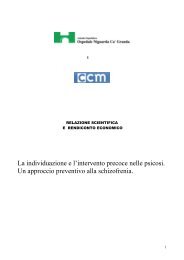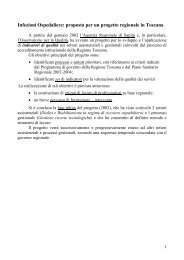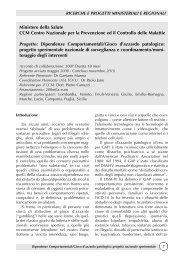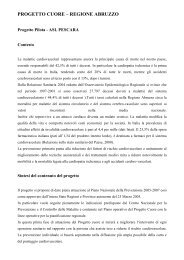Gaining health : analysis of policy development in European ...
Gaining health : analysis of policy development in European ...
Gaining health : analysis of policy development in European ...
Create successful ePaper yourself
Turn your PDF publications into a flip-book with our unique Google optimized e-Paper software.
Chapter 6<br />
254<br />
As premature deaths from NCD decl<strong>in</strong>e, morbidity can<br />
be “compressed” to a later stage <strong>of</strong> life and degenerative<br />
diseases may have longer to develop, potentially lay<strong>in</strong>g a<br />
heavy burden on <strong>health</strong> and social services and on <strong>in</strong>formal<br />
carers. Rais<strong>in</strong>g awareness <strong>of</strong> the value <strong>of</strong> <strong>health</strong> promotion<br />
and preventive measures among <strong>policy</strong>-makers and older<br />
people themselves may be needed, as many may believe<br />
they are too old to benefit by chang<strong>in</strong>g their lifestyle (3).<br />
Problems such as alcohol abuse <strong>of</strong>ten go unrecognized and<br />
the benefits <strong>of</strong> tak<strong>in</strong>g up exercise or giv<strong>in</strong>g up tobacco, even<br />
late <strong>in</strong> life, may be unappreciated. NCD <strong>policy</strong> needs to be<br />
tailored to an age<strong>in</strong>g society.<br />
The <strong>health</strong> <strong>of</strong> children and the way <strong>in</strong> which they are nurtured<br />
through adolescence <strong>in</strong>to adulthood will affect the<br />
prosperity and stability <strong>of</strong> countries over the com<strong>in</strong>g decades<br />
(4). Although children <strong>in</strong> the <strong>European</strong> Region today<br />
benefit from better <strong>health</strong> <strong>development</strong> than ever before,<br />
and <strong>in</strong>fant and child mortality rates <strong>in</strong> some countries are<br />
among the lowest <strong>in</strong> the world, there are strik<strong>in</strong>g <strong>health</strong><br />
<strong>in</strong>equalities both across and with<strong>in</strong> countries. The basis for<br />
good <strong>health</strong> is established even before conception. Healthrelated<br />
behaviour such as smok<strong>in</strong>g, alcohol abuse, physical<br />
activity and eat<strong>in</strong>g patterns can become established from<br />
an early age. The prevalence <strong>of</strong> depressive illness among<br />
the young appears to be <strong>in</strong>creas<strong>in</strong>g, and this is <strong>of</strong>ten l<strong>in</strong>ked<br />
to poor educational atta<strong>in</strong>ment, antisocial behaviour and<br />
substance abuse.<br />
In harmony with the <strong>European</strong> NCD Strategy (1), the<br />
Regional Office’s strategy for child and adolescent <strong>health</strong><br />
(4) recognizes the need for tak<strong>in</strong>g a life-course approach<br />
<strong>in</strong> tackl<strong>in</strong>g chronic disease and disability, by address<strong>in</strong>g the<br />
<strong>health</strong> challenges at each stage <strong>of</strong> <strong>development</strong>. State structures<br />
for formal education are <strong>in</strong> place <strong>in</strong> all countries, and<br />
the school has been an important area for <strong>in</strong>vestment <strong>in</strong><br />
<strong>health</strong> promotion (5). Much greater advantage could doubtless<br />
be made <strong>of</strong> this particular sett<strong>in</strong>g, and the necessary<br />
l<strong>in</strong>ks be made to other sectors. For example, EU regulations<br />
concern<strong>in</strong>g the use <strong>of</strong> surplus agricultural production are<br />
be<strong>in</strong>g adapted to encourage children’s consumption <strong>of</strong> fruit<br />
and vegetables <strong>in</strong> school (6).<br />
In many countries, immigration is vital for population size,<br />
the labour market and economic growth. While some<br />
studies suggest that chronic diseases are less prevalent <strong>in</strong><br />
certa<strong>in</strong> migrant groups, others demonstrate that some<br />
immigrants may be at higher risk for certa<strong>in</strong> NCD, particularly<br />
hypertension, diabetes and certa<strong>in</strong> forms <strong>of</strong> cancer<br />
(7), depend<strong>in</strong>g on their country <strong>of</strong> orig<strong>in</strong> or lack <strong>of</strong> <strong>in</strong>clusion.<br />
In many EU Member States, most <strong>of</strong> the migrants are<br />
on the periphery <strong>of</strong> the labour market with all the signs <strong>of</strong><br />
social exclusion and the difficulties <strong>of</strong> social adaptation and<br />
<strong>in</strong>tegration. Among them, the prevalence <strong>of</strong> harmful habits<br />
can be extremely high. Residency status, language, literacy<br />
and cultural issues can prove further obstacles to access<strong>in</strong>g<br />
care and preventive services. Attempts are be<strong>in</strong>g made<br />
to improve the knowledge <strong>of</strong> migrants’ <strong>health</strong> status and<br />
<strong>health</strong> determ<strong>in</strong>ants, to identify good practice related to<br />
access to <strong>health</strong> services, and to contribute to the def<strong>in</strong>ition<br />
<strong>of</strong> <strong>health</strong> policies and strategies aimed at improv<strong>in</strong>g<br />
migrants’ <strong>in</strong>tegration.<br />
“Obesity presents Europe with an unprecedented public<br />
<strong>health</strong> challenge that has been underestimated, poorly assessed<br />
and not fully accepted as a strategic governmental<br />
problem with substantial economic implications” (8). Rates<br />
<strong>of</strong> obesity are ris<strong>in</strong>g <strong>in</strong> virtually all parts <strong>of</strong> the Region, and<br />
particularly alarm<strong>in</strong>g is the rise <strong>in</strong> childhood obesity. Body<br />
fat accumulates when the energy content <strong>of</strong> the food consumed<br />
exceeds energy expended. Both sides <strong>of</strong> the energy<br />
balance are <strong>of</strong> concern, but less attention has been paid to<br />
physical activity. Simultaneously, work<strong>in</strong>g and liv<strong>in</strong>g environments<br />
become “obesogenic”, <strong>in</strong>creas<strong>in</strong>gly discourag<strong>in</strong>g<br />
physical activity. Tackl<strong>in</strong>g obesity requires a broad <strong>in</strong>tersectoral<br />
approach.<br />
Po<strong>in</strong>ters to the future



